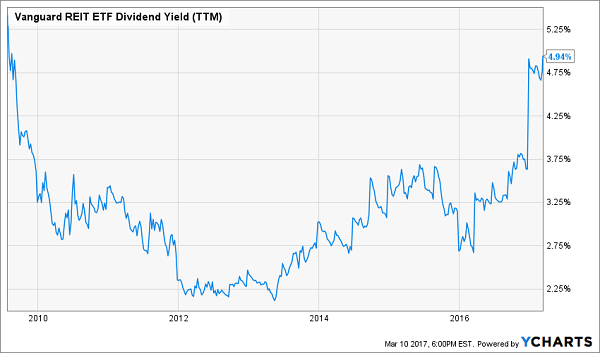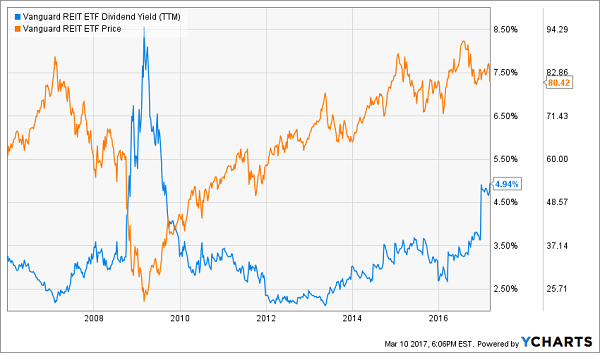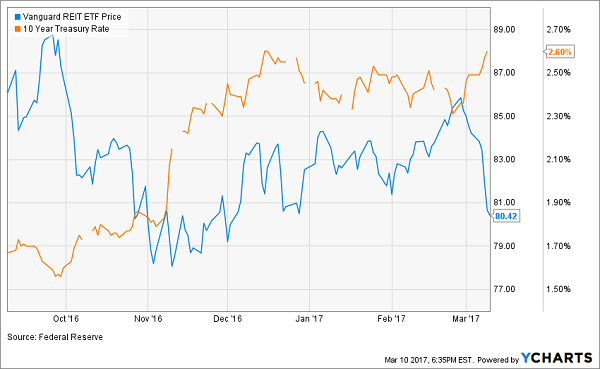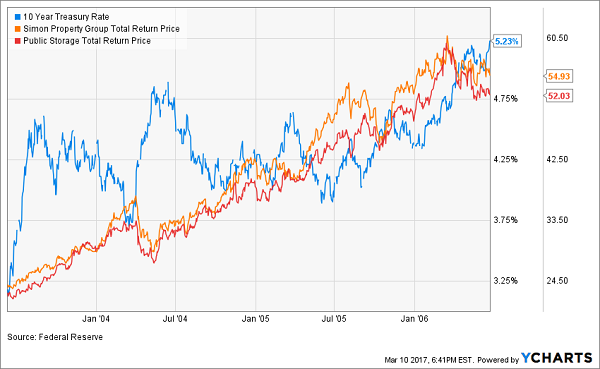There hasn’t been a better time to buy real estate investment trusts (REITs) since July 2009. That was the last time this “simple signal” flashed B-U-Y.
Investors who bought on this signal then have enjoyed 223% returns since. And those gains didn’t require any fancy stock picking – just a one-click purchase of the Vanguard REIT ETF (VNQ).
The signal? VNQ itself paying 5%:
Highest REIT Yields Since the Financial Crisis

Most income hounds get it wrong. They pile into REITs when their yields are low because they are desperate for any positive income stream. That’s a bad idea because there are only two ways REITs can pay you:
- With today’s dividend, and
- With tomorrow’s (hopefully higher) payout.
As with stocks in general, it’s usually a bad move to accept a lower-than-usual dividend today in hopes of future growth. That’s a sure way to guarantee underperformance.
A better strategy is buying stocks – especially REITs – when their yields are higher than usual. Over VNQ’s 11-year history, its price has tended to mirror its yield:
Buy VNQ When Yield is High

But Isn’t This Time Different?
“First-level” investors – those who buy and sell on headlines – mistakenly believe that real estate investment trust (REIT) profits will suffer if rates rise.
Sure, in the short run, the “rates up, REITs down” theory puts on quite the show. When the 10-Year Treasury’s yield rises, REITs usually fall. And when its yield drops, REITs usually rally. This inverse relationship tends to hold up over multiple days, weeks and even months:
A Short-Run Seesaw Between REITs and T-Bill Yields

The theory backing up this price action says that, because REITs borrow money to grow their property empires, they need cheap cash. Yet this isn’t a “must have” criterion for all such landlords. If their costs increase, they can simply raise the rents when the lease is up for renewal, passing on their higher borrowing costs to tenants.
For example, let’s look at a three-year period starting in May 2003 when the 10-year rate climbed two full basis points – from 3.2% to 5.2%. Based on recent REIT price action, you’d expect most firms would be out of business!
But blue chips such as mall operator Simon Property Group (SPG) and self-storage stalwart Public Storage (PSA) not only survived the rate increases – they thrived:
The Best REITs Climbed With Rates

Why? Because rising rates signaled a booming economy – one in which these firms had no problem raising their rents. Both boosted dividends while investors in each stock enjoyed 129% total returns over the three-year period!
Which REITs Will Thrive This Rate Hike Cycle?
Firms having no problem issuing rent increases today are easy to spot. They report higher and higher funds from operations (FFO) year after year, which finds its way back to shareholders in the form of an ever-rising dividend.
My favorite REIT today has come a long way since its CEO, Ed, founded the firm fourteen years ago. He admits that back then he had: “zero assets, a dream, and a business plan.”
His dream and plan were plenty – Ed parlayed them into $6.7 billion in assets!
Investors have enjoyed 86% total returns over the last five years (with much of that coming back as cash dividends.) And right now is actually a better time than ever to “bet on Ed” because his growing base of assets is generating higher and higher cash flows, powering an accelerating dividend:

Yet for some shortsighted reasons I’ll explain shortly (plus the rate concerns we discussed), Ed’s stock is such a bargain that it pays a gaudy 7.6% yield today. Much higher than usual.
This stock that should be owned by any serious dividend investor already, for three simple reasons:
- It’s recession-proof and rate-proof,
- It yields a fat and secure 7.6%(!), and
- Its dividend increases are accelerating – and this is typically a cue that big price gains are ahead.
Which is why you need to buy Ed’s stock right now – before its price gets bid up (and its yield gets compressed). I also have two more rate-proof REITs that I love right now, hidden gems actually paying 8% and 9% respectively thanks to similar headline-driven hysteria. Click here for the details about these favorite 7.6% to 9% REITs of mine – and I’ll share the names, tickers and buy prices with you, too.
